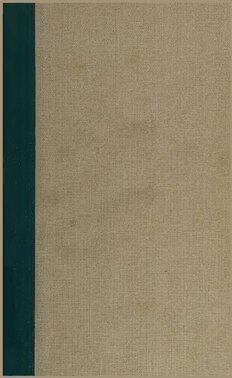
The Buddhist Revival In China PDF
Preview The Buddhist Revival In China
, .... ..... .. ······. ... ........ ·-·,_-·-,. ·····. ··· .. ·· ····.. ..... . ...... . . ..� .. ...· ·. CHINA Citiaensd t owns welkln-own. �.. .� .··-:... . • witft 13uddhist monasteries • r;vcou-T>nutdadihnwisitsh rwmeoUn-aksntoewrrvi es .. ... .. :·· �. ..• . ... � ()omeo thewre ll-knBou�dndh ist' monasteries ········. ...· ":. .: ... .. .· ""\ ...... ·· ............ l tu Kai-chiam ngtu N � vJ A OMEJ SHAN •c �C hun9k1•ng • �\\[f..� � f IND I.A_, 92° 96° 100° 10 ° HARVARD EAST ASIAN S EH I E S, 33 THE BUDDH IST REVIVAL IN CH IN A The East Asian Research Center at Harvard University administers research projects designed to further scholarly understanding of China, Korea, Japan, and adjacent areas. HOLMES WELCH THE BUDDHIST REVIVAL IN CHIN A with a section of photographs by HENRI CARTIER-BRESSON HARVARD UNIVERSITY PRESS Cambridge, Massachusetts, Ig68 © Copyrig19h6t8 byt heP RESIDENT AND FELLows OF HARVARD COLLEGE Allr ighrtess erved DistribuitnGe rde aBtr itabiynO xforUdn iversPirteys Lso,n don LibraorfyC ongreCsast aloCga rdN umber6 8-15645 Printiendt heU niteSdt atoefsA merica Preface This is the second in a series of three volumes on Buddhism in modern China. Whereas the first dealt with its system and institutions, this deals with its history, focusing on its rapid evolution in the three decades prior to the Communist victory of 1949. The third volume will take up what has happened (both institutionally and historically) under the Communist regime. One problem in producing a series is how much to repeat. Should each volume be independent? Or may the author refer to explanations he has given earlier? As might be expected, I have chosen a middle course. Whatever is essential for under standing has, I hope, been included between these covers; but the reader will often be referred to my Practice of Chinese Buddhism (Harvard University Press, 1967) for amplification and incidental intelligence. Although the preface of the latter serves the present volume as well, two points bear repetition. First, the following account of the Buddhist revival in China focuses on men, organizations, and events, and deals only inci dentally with doctrinal developments and intellectual history. Second, it is not exhaustive. It would have taken more time than was available to me (another two or three years) to complete the exploitation of even the basic source materials-hence the refrain in the notes that "more investigation is needed." It may also be worth noting that, whereas about a third of the data in the preceding volume came exclusively from interviews, the proportion is somewhat less in the pages that follow; and a larger proportion of such interview data comes from single informants rather than from the collation of interviews with several. VI PREFACE For active assistance in gathering material, reading parts of the manuscript, and suggesting improvements I want to thank Robert N. Bellah, Martin Bernal, Paul A. Cohen, Winston Hsieh, P. Y. Hsing, Sidney Liu, Shigeru Matsumoto, Masatoshi Naga tomi, David Roy, Vincent C. T. Shui, Ernest Young, Mrs. John Quirk, and Mrs. Noriko Tamada. Mrs. John Mitchell read over the whole manuscript, as she had its predecessor, without being thanked until now. l am particularly indebted to Mr. Zunvair Yue (Yii Ching-yii), who went over each page with expert care and found many errors. The generosity of the Reverend Henry P. King ·made it possible to include the photographic essay by Henri Cartier-Bresson. Although during most of the preparation of this volume I was on the staff of the East Asian Research Center at Harvard Uni versity, some of the material had been collected during the three previous years, when I was receiving a grant from the Joint Committee on Contemporary China. I take this opportunity to express my gratitude to both institutions. I owe the greatest debt to the Chinese Buddhist monks and laymen whose kindness to a stranger and whose patience in answering his questions have well exempli£ed the bodhisattva path they follow. Mrs. S. C. Chiu has once again proved herself the best typist in the Far East, while my wife is still my favorite editor. HOLMES WELCH Concord, Massachusetts October 1967
